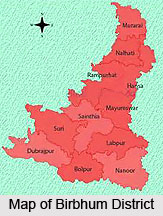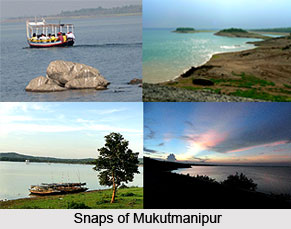 Bankura district, located in the state of West Bengal, finds mention in the ancient Buddhist and Jain scriptures. It lies in the heart of the ancient Summha area of Mahabharata or Rarh or Larh of the old Jain Acharanga-sutra. Mention has also been made of the district in the ancient Buddhist Jatakas as Summhabhumi. Bankura district today is bordered by the Purulia district, Bardhaman district, Hooghly district and Midnapore district. It is situated between the hilly terrain of Chotanagpur and Santal Parganas of Bihar on the one side and the fertile alluvial plains of West Bengal on the other. There are a number of temples located at Bankura district, especially in the district of Bishnupur, which are prime attractions of the district. Being a district with a very high tribal population, Bankura district abounds in cultural variety seen in the art, music and performing arts of the place.
Bankura district, located in the state of West Bengal, finds mention in the ancient Buddhist and Jain scriptures. It lies in the heart of the ancient Summha area of Mahabharata or Rarh or Larh of the old Jain Acharanga-sutra. Mention has also been made of the district in the ancient Buddhist Jatakas as Summhabhumi. Bankura district today is bordered by the Purulia district, Bardhaman district, Hooghly district and Midnapore district. It is situated between the hilly terrain of Chotanagpur and Santal Parganas of Bihar on the one side and the fertile alluvial plains of West Bengal on the other. There are a number of temples located at Bankura district, especially in the district of Bishnupur, which are prime attractions of the district. Being a district with a very high tribal population, Bankura district abounds in cultural variety seen in the art, music and performing arts of the place.
Location of Bankura District
Bankura district is located in the western part of the state of West Bengal. It is a part of Bardhaman Division of the State and included in the area known as "Rarh" in Bengal. The District of Bankura is located between latitude 22 degree 38 minutes North and longitude 86 degrees 36 minutes east to 87 degrees 47 minutes East. The Damodar River flows along the northern boundary of the district. Bankura is bounded by Bardhaman District in the North, Purulia District in the West and Paschi Medinapure district in the South.
Geography of Bankura District
There are three main seasons found in the Bankura district. These include hot summer (April-May), monsoon (June-September) and winter (November-February). The humidity is usually at a medium to high level throughout the year and the rainfall, though not too heavy, is usually well distributed. The average annual rainfall in the district is around 1300 mm. Maximum rainfall is usually received in the months of July-August. Two agro-climatic zones are found in the district, namely undulating red and laterite soil and Vindhyan Alluvial Zone.
 The two have different geological features, and whereas agriculture in the former is rain-dependant, agriculture in the Vindhyan Alluvial zone is dependent on canal and ground water irrigation. Rice, Wheat and Oilseeds are among the principal crops grown in the region. Among the oilseeds, rape seed, mustard and sesamum are the most important. Forest lands cover 148177 hectares, which constitutes 21.5 percent of the total geographical area of the district.
The two have different geological features, and whereas agriculture in the former is rain-dependant, agriculture in the Vindhyan Alluvial zone is dependent on canal and ground water irrigation. Rice, Wheat and Oilseeds are among the principal crops grown in the region. Among the oilseeds, rape seed, mustard and sesamum are the most important. Forest lands cover 148177 hectares, which constitutes 21.5 percent of the total geographical area of the district.
Economy of Bankura District
An overwhelming agro-economic base and low urbanisation and industrialisation characterize the economy of the district of Bankura. The district is broadly divided into two regions: the alluvial plains in the east and the undulating tract to the west. Within the district and even within these regions, the villages vary not only in their geographical features but also in their physical forms and composition of their economic and social life patterns. Agriculture forms the prime contributor to the economy of the district. The net cultivable area of the district is 4.30 lakh hectares, and about 46 percent of the net cropped area is under irrigation. Mines and minerals play a vital role in the economy of Bankura district. Mines and minerals based ventures have already come up on the stretch of land from Bankura to Saltora. Certain blocks like Bishnupur, Sonamukhi, Patrasayer, Indus, Joypur, Kotulpur have been setting up agriculture based industries like, Rice and Oil Mills. Cottage and Small Scale Industries constitute a major segment of the district`s economy. It provides maximum employment opportunity next to agriculture and this account for nearly 9 percent of the district income. The forests in the district produce various medicinal flora and fauna which are routinely exported to neighbouring districts and also outside the state.
Tourism in Bankura District
A number of places of tourist interest are found located in the Bankura district. Most of these places are places of remarkable natural beauty, calm and undisturbed in their environment. Popular tourist spots in the district include the Susunia district, Biharinath hill which is the highest hill in the district, the Mukutmonipur- Jhilimili circuit full of lush green forests and sparkling blue water from the Kangsabati Water Resorvoir. Among places of pilgrimage tourism here are the Bishnupur group of temples, remarkable for their terracotta art.






